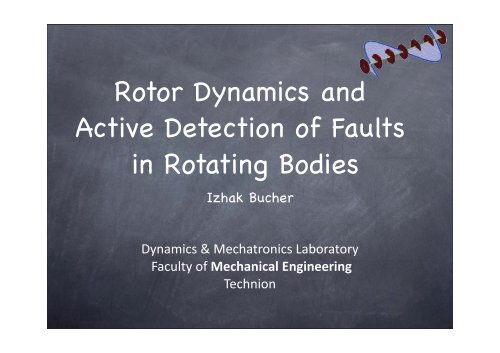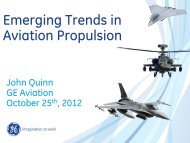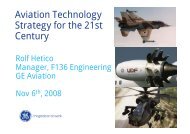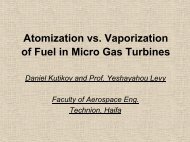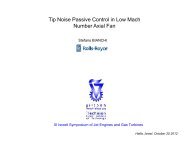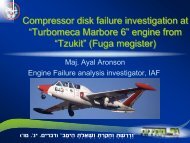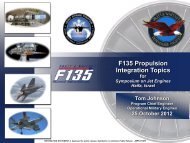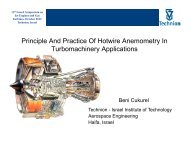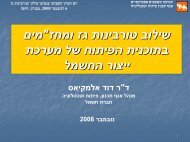7. RotorDynamics and Active Detection of Faults in Rotating Bodies
7. RotorDynamics and Active Detection of Faults in Rotating Bodies
7. RotorDynamics and Active Detection of Faults in Rotating Bodies
- No tags were found...
Create successful ePaper yourself
Turn your PDF publications into a flip-book with our unique Google optimized e-Paper software.
Rotor Dynamics <strong>and</strong><strong>Active</strong> <strong>Detection</strong> <strong>of</strong> <strong>Faults</strong><strong>in</strong> Rotat<strong>in</strong>g <strong>Bodies</strong>Izhak Bucher
Rotat<strong>in</strong>g Mach<strong>in</strong>ery vs. non-rotat<strong>in</strong>gDynamicsVibrationIdentificationsignal process<strong>in</strong>gSpeed/Time dependentWhirl vs. vibrateAsymmetry & rotationMany response frequenciesI. Bucher
Disk dynamicsDifferences & similaritiesForward/backward travel<strong>in</strong>g modes (waves)Different wavelength travel at different speedsMost modes (n>1) are de-coupled from shaftmust measure on disk directlyCannot excite from shaft (n>1)Need more sensors (or a scann<strong>in</strong>g laser)I. Bucher
Effect <strong>of</strong> rotationRotat<strong>in</strong>g disc Frequency modulationmodal forceresonanceI. Bucher
RotationStationary excitation & responseMode waveforward backward st<strong>and</strong><strong>in</strong>gresonanceI. Bucher
Disc vibration - SummaryForce frequencySpeed <strong>of</strong> rotationResponse frequencies , ±2nResonance frequencies , ±nResponse spectrumForce spectrumfrequencyfrequencyI. Bucher
Transient signal&signal process<strong>in</strong>gI. Bucher
Double sided Spectrumfor a shaftI. Bucher
Forward & backward whirlseparationI. Bucher
Swept s<strong>in</strong>e (runup)• PsdI. Bucher
Time-frequency• SpectrogramI. Bucher
Campbell diagram<strong>and</strong> time-frequency distributionFrequencySlid<strong>in</strong>gw<strong>in</strong>dowsignalSpeedtimeI. Bucher
Campbell diagram - measuredfrequencyOne sidedDouble sidedtime (speed)time (speed)I. Bucher
disk dynamics (cont.)I. Bucher
Complete test-rigI. Bucher
spectrogram n=2<strong>in</strong> disc coord<strong>in</strong>atesunbalancefwdbackwardsI. Bucher
Test Rig - OverviewLaserMeasurement &control systemSensorsActuatorsI. Bucher
Exist<strong>in</strong>g test rig @I. Bucher
Us<strong>in</strong>g laserDisksMeasurement systemI. Bucher
<strong>Active</strong> fault detection <strong>in</strong>rotat<strong>in</strong>g partsI. Bucher
21Actuator &sensorActuator &sensorI. Bucher33Technion, ISRAEL
St<strong>and</strong>ard fault diagnostics<strong>Faults</strong> can cause high harmonics <strong>and</strong> modulation <strong>in</strong> thenormal vibrationsspeed responseConventional fault diagnosticsUse measurements dur<strong>in</strong>g operationSignal process<strong>in</strong>g, neural networks <strong>and</strong> statisticsIn practice,Small defects produce small changes <strong>in</strong> the signalsUnbalance dom<strong>in</strong>ant responselow SNR for detection <strong>of</strong> faultsConsequently: <strong>Faults</strong> are only detected when theyexceed dangerous levelsI. Bucher
Whirl <strong>in</strong> presence <strong>of</strong> a crack0 O0 Oforward 50.4 [Hz]Stress - constant180 O180 O 0 O360 OStatic StressbackwardsStress-50.1 [Hz]1x0 OStress 2x90 O0 O180 O180 O0 O 360 ODynamic Stress
Gasch (1976) - “Breath<strong>in</strong>g Crack Model”General non-l<strong>in</strong>ear EOMWeight dom<strong>in</strong>ance assumptionL<strong>in</strong>ear Periodic Time VariantM q + (C + G) q + (K 0+ K(t)) q = f (t) Kq 0In papers crack depths are taken at 40% -75% !!!Gasch, R., "A Survey <strong>of</strong> the Dynamic Behavior<strong>of</strong> a Simple Rotat<strong>in</strong>g Shaft with a TransverseCrack", Journal <strong>of</strong> Sound <strong>and</strong> Vibration, Vol.160(2), pp. 313-332, 1993.
First forward critical speed :62.9 Hz2nd forward critical speed:208 HzI. Bucher
Notch onlyNotch & CrackLog scaleLog scaleFeature is several orders <strong>of</strong> mag. Smaller than normal dynamicresponse!!!Bucher, I., Seibold, S., "Us<strong>in</strong>g comb<strong>in</strong>ed Temporal <strong>and</strong> SpatialInformation <strong>in</strong> Multi-hypothesis Damage <strong>Detection</strong>", Proc. Of theXV <strong>in</strong>t. Modal Analysis Conf. Orl<strong>and</strong>o, Florida, 1996. 24I. Bucher
Kirson Y. Problems relat<strong>in</strong>g to balanc<strong>in</strong>g <strong>of</strong>asymmetrical rotors, M.Sc. Thesis, Faculty<strong>of</strong> Mechanical eng<strong>in</strong>eer<strong>in</strong>g, Technion, Israel,1969.Deviatory <strong>in</strong>ertiaMean <strong>in</strong>ertiaAsymmetry RatiosmallI. Bucher
Body-fix cords.Rotation matrixResponse <strong>in</strong> <strong>in</strong>ertial C.S. & Taylor expansion O( J2)S<strong>in</strong>gle frequencyNo isolationHigh sensitivity near critical speed29I. Bucher
Shaft anisotropyDeviatory stiffnessMean stiffnessResponse <strong>in</strong> <strong>in</strong>ertial C.S. & Taylor expansion O( J2)3341
34I. Bucher
sensorHarmonic balance & Taylor expansion O( J2)I. Bucher
=94 [Hz] =52 [Hz] 2 - =136 [Hz]ExcitationFreq.UnbalanceresponsesimulationModulatedFreq. 2 - =136 [Hz]Asymmetry -<strong>in</strong>dicator47I. Bucher
53I. Bucher
I. Bucher
asymmetric rotor with <strong>and</strong> without active prob<strong>in</strong>gexperiment5747
Top speed 2250RPM20 RPM/Sec= 101.5Hzfrequencyspeed58I. Bucher
frequencyspeed59I. Bucher
Waterfall diagram <strong>of</strong> speed-frequency mapssymmetricasymmetricI. Bucher 61
I. Bucher
63I. Bucher
Thank youI. Bucher
Math. backgroundFloquet, G.1883Lyapunov, A.M., 1892Yakubovich,Dynamic <strong>in</strong>vestigationCr<strong>and</strong>all, S.H.,Brosens, P.J.,1961Yamamoto, T.,Ota, H., 1963Tondl, A., 1991Fault detectionIwatsubo, Arii<strong>and</strong> Oks 1992Seibold, S., <strong>and</strong>We<strong>in</strong>ert, K.,1996Isermann, R.,19972554
Angular unbalanceAsymmetric discDoF - Angular deflectionse1e3e2Angular velocity <strong>in</strong> rotat<strong>in</strong>g C.S.EoM <strong>in</strong> rotat<strong>in</strong>g C.S. for unbalance (synchronous) excitation28I. Bucher
Perfectly balanced sys.External momente1e3e2EoM – body-fixed C.S.Solution – body fix C.S.30I. Bucher
Perfectly balancedSymmetric disce3Anisotropic rotat<strong>in</strong>g stiffnesse1e2EoM – body-fixed C.S.32I. Bucher
Classical Rotor Dynamics Modell<strong>in</strong>g3-D model : current practices for axial mach<strong>in</strong>ery• Complete model us<strong>in</strong>g twolevels <strong>of</strong> super-elements• Expensivehuge modelmust ignore many effects to analyseThis document is the property <strong>of</strong> SAMTECH S.A.Norbert KillExeter,September 10th 2008, Page
Classical Rotor Dynamics Modell<strong>in</strong>g3-D model : current practices for axial mach<strong>in</strong>eryOne sector wheresome stages areidealized :Several blades per stage <strong>in</strong> orderto obta<strong>in</strong> cyclic symmetry:smaller modelignore more effects to analyseThis document is the property <strong>of</strong> SAMTECH S.A.Norbert KillExeter,September 10th 2008, Page
Structural Dynamics Toolbox• Structural Dynamics Toolbox <strong>of</strong>fers :– 3D F<strong>in</strong>ite Element Model<strong>in</strong>g– Experimental Modal Analysis– Test / Analysis correlation– Modular approach• MATLAB environmentCADMesh<strong>in</strong>gFEMSimulation• OpenFEM : Core FE s<strong>of</strong>tware Tests• FEML<strong>in</strong>k : Import / export <strong>in</strong>dustrial modulesRuntime SDTSDT, Visco, Rotor, …OpenFEM FEMl<strong>in</strong>kMATLAB• Custom extensions (Rotor, Visco, Runtime)• SDT Rotor extends capabilities <strong>in</strong> rotordynamics– 1 D beam/mass (critical speed, Campbell, forced response)– 3 D cyclic symmetry <strong>and</strong> full rotor super-element– Time doma<strong>in</strong> (rotor/stator <strong>in</strong>teraction)NASTRANPERMASSAMCEFANSYSUFF / IDEASABAQUSAdamsSimul<strong>in</strong>kIDEAS TestExcel
SDT Rotor1 D beam/mass (critical speed, Campbell,forced response)3 D models– Cyclic symmetry (mono <strong>and</strong> multi-stage)– Sector super-element (mono <strong>and</strong> multi-stage),mistun<strong>in</strong>g, rogue blade, sector model, full <strong>and</strong>partial restitution, test/analysis correlation, …– Campbell diagram (body fixed model)– Inertial, thermal <strong>and</strong> pressure loads,temperature dependent materialsTime doma<strong>in</strong> (rotor/stator <strong>in</strong>teraction)– Shaft superelement <strong>in</strong> body fixed framee y NL– Non-l<strong>in</strong>ear bear<strong>in</strong>g models (currently only NLstiffness <strong>and</strong> damp<strong>in</strong>g)simulation resultreally hard to underst<strong>and</strong>Currently beta, stable release 2009Images A. Sternchuss, funded by SNECMALocalization due to mistun<strong>in</strong>g, full shaft mode/diameter analysis,Campbell diagram for mistuned disk, time simulation <strong>of</strong> an eng<strong>in</strong>e withgyroscopic effects (funded PSA)
Inertial C.S.Body-Fixed C.S.I. Bucher
Inertial C.S.General formSeries Solution (FLT)37I. Bucher
65I. Bucher
Eng<strong>in</strong>e order doma<strong>in</strong>+forwardtime (speed)-backwardI. Bucher
Top speed 2250 RPM, acceleration 20 RPM/sec .60I. Bucher
26I. Bucher
Non-synchronous excitationNatural dynamic response<strong>Detection</strong> stageFeature isolationSensitivitySpectral separationAt early stagesUnique, fault dependentfeature signal.High sensitivity to smallchangesTuneable frequency, applicablefor any speed <strong>of</strong> rotationWhen the fault is severeNo isolation. AdditionalPhenomena may appear near orat the same freq - mask<strong>in</strong>gLow sensitivityNo control over frequencySignal amplificationSignal to noise ratioAdditional S.P.By wisely choos<strong>in</strong>g theexcitation freq.High S.N.R, adjustableUsually not requiredOnly when near critical speedUsually low, unless near criticalspeedMay require sophisticatedalgorithms for enhancement62I. Bucher
I. Bucher
Externally appliedmomentInertia asymmetrysensitive responseSpectral separationAdjustable, high sensitivityNon-hazardous work<strong>in</strong>g po<strong>in</strong>t3170


